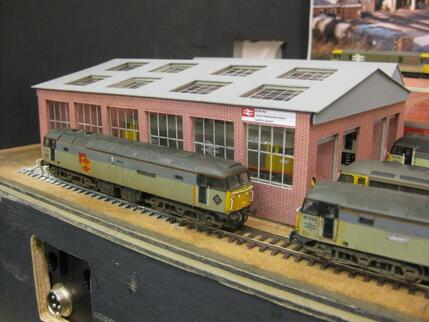Camford Junction TMD 2mm Fine scale
|
Camford is a fictional location, based somewhere in the area of Yeovil in the period 1992-95, the last days of British Rail before privatisation. During this period there were a number of different liveries being carried by locomotives, from Rail Blue through to the post-sectorisation of Transrail, Mainline and Loadhaul, many of which can be seen on the models running on the layout.
Camford Junction is where the “Heart of Wessex” line from Westbury meets the South West Main Line from Salisbury. Passenger services are provided by Network SouthEast and Regional Railways, and it is also used as a diversionary route for InterCity Cross Country services. There is a high level of freight traffic, again due to the area's frequent used as a diversion, and some of these freight trains are marshalled into the nearby sidings and the locomotives move onto the servicing depot for fuelling and/or minor maintenance as and when required. There is also a small amount of shunting of fuel tank wagons and vans around the depot area. |
The model is built to 2mm Scale Association standards using code 40 flat bottom rail using the 2mm Scale Association “Easitrac” system , and some on soldered PCB sleepers. This is a finescale version of N gauge, and, in fact, many so called N scale models are made to 2mm/ft (1/152.4) scale. The track gauge is 9.42mm, as opposed to the 9mm used by 'N' gauge, and is built with very fine clearances.
The bridges at each end of the layout are by Scalescenes, as is the brickwork and viaduct arches on the high level lines. Both the locomotive and DMU sheds were built for us by Weston Models. The ancillary buildings are scratchbuilt using Scalescenes texture sheets, plasticard and plastruct. The lighting towers are by Scalelink and the signals by CR Signals. Most of the locos are proprietary N-gauge, detailed and re-wheeled to 2mm Scale Association standards, and the rolling stock is a mix of proprietary N-gauge (some modified and detailed) and kit-built. DG couplings are fitted to the stock used for shunting in order to allow hands-free operation. The layout baseboard and the fiddle yards are constructed from 6mm and 9mm ply with 2mm MDF on top, all supported on timber legs. The layout will use the MERG's CBus layout control bus to control points, etc. |


